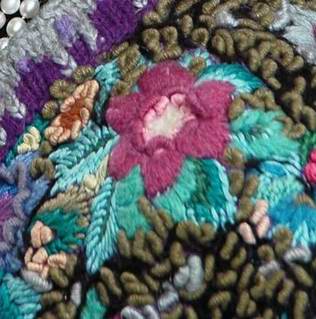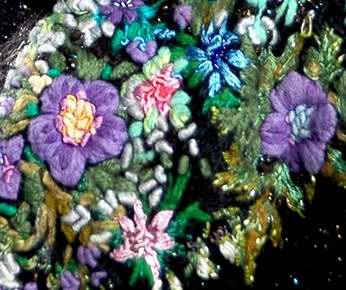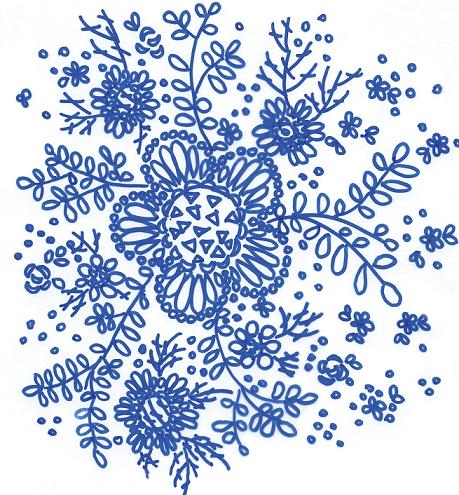Flowers on Knit Clothes
 What did this all start from? When did all these flowers get power on me so that I can't give them up for so many years? How is it happening that an idea is born and then comes realized? All these questions are still of importance to me, they were asked and should be answered.
What did this all start from? When did all these flowers get power on me so that I can't give them up for so many years? How is it happening that an idea is born and then comes realized? All these questions are still of importance to me, they were asked and should be answered.
It was in 1993. If you happened to be in Russia at that time, you must remember that it was really difficult, hectic time, when it was easier to say what was on sale in stores rather than what was missing. It was in that time that I learnt satin-embroidery or fill stitching (really high time, as I was already over thirty!). I was omnivorous about it, stitching everything I only could, without distinction. Recently I watched a home made video of those years and was surprised myself to see that literally everything in my house was marked with embroidery - monograms on the shirts of my husband and son, butterflies on the daughter's raincoat, my own clothes stitched almost all over. From good to better, more and more
when suddenly in a fashion magazine I came across pictures of knitted clothes (black and white) decorated with free-style embroidery. There were no explanations on how to do it, I had to use my own imagination. As for the result - you can see it on the picture.
Since I don't know how the others do it, I will explain my own approach.
 I will tell you what techniques I use in stitching knitted clothes. But it is solely up to you to decide what kind of flower garden you will create using your braveness, imagination and ambition. Well, let's start!
I will tell you what techniques I use in stitching knitted clothes. But it is solely up to you to decide what kind of flower garden you will create using your braveness, imagination and ambition. Well, let's start!
- 1. First you should decide what parts of clothes you will cover with stitching. You may stitch cuffs, foreparts, back part of a jacket or a cardigan. Or you may choose to cover the whole jacket or cardigan with stitching; embroider a collar; try to stitch part of a hat or a whole hat. One difficulty is to follow symmetry in your work. I usually stitch the two sleeves or foreparts in parallel and fill them gradually with details.
- 2. Another difficulty is the material tension because we can not use a stitching hoop or frame for knitted things. Nevertheless, I may assure you that you will be able to find a suitable way of holding the material. Just follow one principle: handle it delicately, do not stretch in all directions and do not pull threads tight.
- 3. Daisy stitch (another name is detached chain stitch) is used to make flower petals. Centers of the flowers are filled with French knots or bullion knots (worm knots). You may also use beads, artificial pearls, finally why not use drilled-through stones? You may border the flower contour with beads, as it is done on the collar of my coat. Leaves can be formed with any of the following stitches: daisy stitch, satin stitch, chain stitch or stem stitch. My tip for beginners: do not try to use many stitch types at once. First master satin stitch and daisy stitch. These two stitches are most gratifying and can be enough to create a beautiful motif.
 4. The foundation fabric must be a non-shrinkable, dense enough stockinet from a natural yarn (cotton, wool). For example, an old cardigan, pullover or part of it may serve a good foundation. Of course, you may knit a new jacket but it always takes time. Sometimes I first make a stitched part to which I then attach other parts. This approach I used to make a black jacket.
4. The foundation fabric must be a non-shrinkable, dense enough stockinet from a natural yarn (cotton, wool). For example, an old cardigan, pullover or part of it may serve a good foundation. Of course, you may knit a new jacket but it always takes time. Sometimes I first make a stitched part to which I then attach other parts. This approach I used to make a black jacket.
- 5. The color of the foundation is very important, as the color of the threads tends to change its brightness depending on the foundation. Take two contrast foundations: white (light) and black (dark) and the threads you want to use for stitching. They will look differently against different backgrounds: the light foundation will make them look darker and vice versa. Care should be taken when choosing "difficult" colors for the foundation - it was a real pain in the neck for me to match colors for a violet cardigan! But if you want to cover the whole surface of an article, the color of the foundation does not matter. For example, I used parts of a blue pullover to make a black jacket.
- 6. A needle should be big and have a big eye (a so-called milliner or straw needle). The tip of the needle should not be very sharp, otherwise it will prick your hands and knees.
 7. Threads from wool will do excellently. Choose high quality slightly shrinkable threads in 100 g and over 300 m skeins. The quality of the threads is of utmost importance - it will be a real pity, if after a couple of washes your quilt will shrink or bleed off. Semi-wool threads with a bit of mohair content will also do. And of course beads. Beading will be a separate topic for a later discussion. Alpaka wool would be also nice to use. As for boucle, long mohair and other decorated types of threads (like glittering threads or threads with knots), they can be used with certain care. First, it would be rather difficult, but if it perfectly fits your idea and won't be used too excessively, then you may get an interestingly looking effect.
7. Threads from wool will do excellently. Choose high quality slightly shrinkable threads in 100 g and over 300 m skeins. The quality of the threads is of utmost importance - it will be a real pity, if after a couple of washes your quilt will shrink or bleed off. Semi-wool threads with a bit of mohair content will also do. And of course beads. Beading will be a separate topic for a later discussion. Alpaka wool would be also nice to use. As for boucle, long mohair and other decorated types of threads (like glittering threads or threads with knots), they can be used with certain care. First, it would be rather difficult, but if it perfectly fits your idea and won't be used too excessively, then you may get an interestingly looking effect.
- 8. Since you won't be able to draw a pattern on the article to be stitched, as you usually do it when stitching a plain canvas, it is necessary to mark locations for future big symmetrical motifs. First stitch big elements, then small ones. In other words, first make big flowers, then engrave them with leaves, then stitch small flowers, branches and leaves.
I hope you got interested. I may confess to you - stitching is a difficult job, the needle pricks. Sometimes I got so enthusiastic that sew the clothes that were on me to the stitched pieces. But as the result you will get a unique thing which will be difficult to copy because you were free in your fantasy to create it.
This way of decorating clothes has its advantages but it has difficulties too. The biggest advantage is a free choice of techniques, threads and patterns. There are embroiderers who make very complicated works strictly following designs from magazines. I do respect them but I wrote this article not for them.
Several words about beads and other drilled glass, stone or acrylic stuff. I still can't understand how it happened that an advanced and sophisticated master as I am has been indifferent to beads for so many years. Does it mean that I failed to see its beauty? May be I simply could not imagine the practical use of it in my works.
One of patterns I use for stitching:

But now my house is full of beads and whatever I'm creating, I do it with beads. One of my friends one said to me "Sveta, you are treating the needlework as a game. Today you are playing at beading, tomorrow you'll get bored and find another game for yourself". At first I was against such statement but then I thought that it might be true. There was time when I got very enthusiastic about multicolor knitting, later I got interested in satin stitching, followed with embroidering clothes, machine stitching
It was immensely interesting to make bubble patterns on kids' clothes... Something new always popped up, old interests receding into the background.
Recently I have knitted heaps of multicolored free-style caps with beads interweaved on the knitting thread. Now I am knitting a cotton T-shirt with beads. Then, before summer begins, I'm planning to knit a summer dress with beads for my daughter. I'm very happy to be able to create unusually looking knitted fabric. And I think it is great to play and to enjoy new playings!
There is a flower garden in every woman's heart. It does not necessarily look real. My garden is pinky lilac. I adore light blue, pearly, silver, turquoise colors and
can't stitch flowers with orange petals. Look inside yourself and listen to the colors of your soul
and you will be a success.